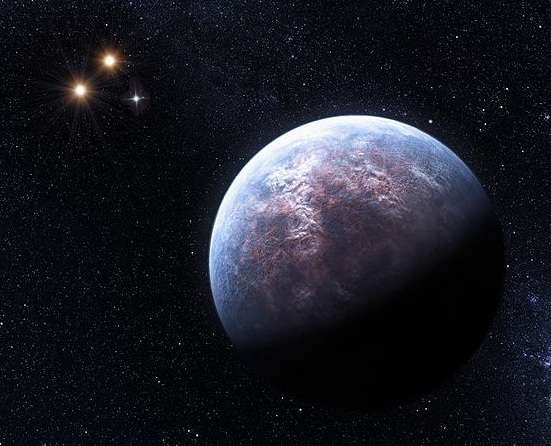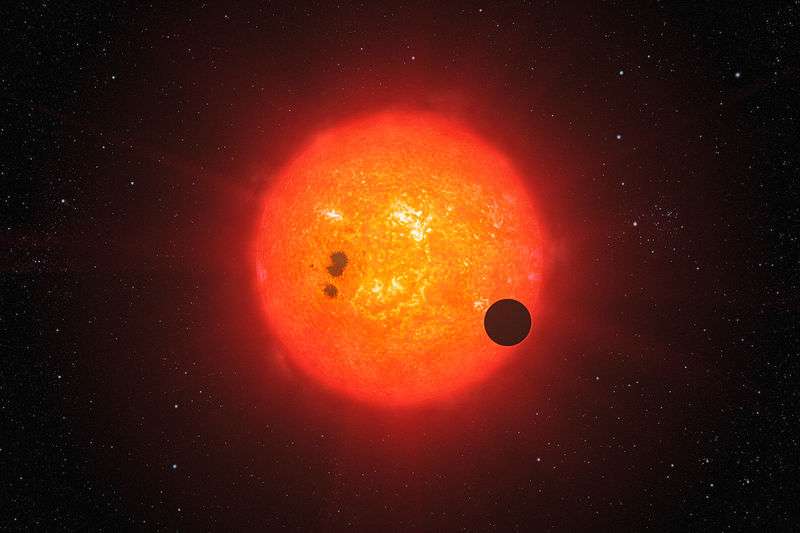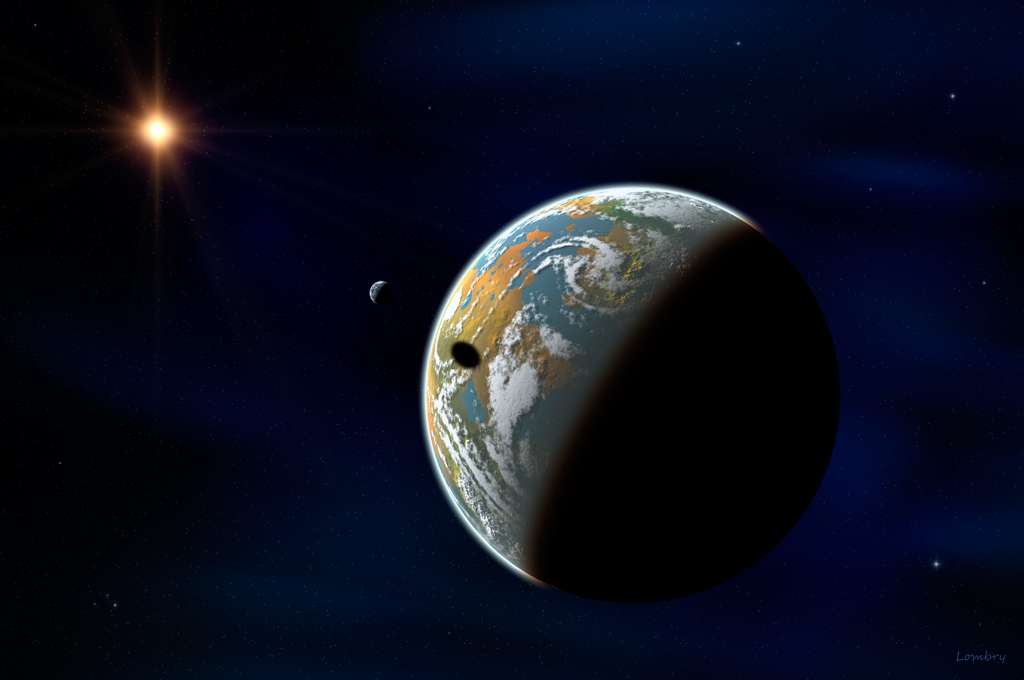It looks like you're using an Ad Blocker.
Please white-list or disable AboveTopSecret.com in your ad-blocking tool.
Thank you.
Some features of ATS will be disabled while you continue to use an ad-blocker.
4
share:
Water is everywhere here, on our Earth. It covers 70.9% of the Earth's surface and is vital for all known forms of life.
As astronomers continue to discover more exoplanets, the focus has slowly shifted from what sizes such planets are, to what they’re made of; then, the detection of liquid water on these exoplanets became a key ingredient for the formation of life as we know it.
Several important discoveries has been made since a decade and there are now strong clues that indicates the presence of vast amounts of liquid water on some of these exoplanets:
1- Gliese 581 d

The planet is within the habitable zone where liquid water could exist. That was corroborated in 2011 by a climate simulation study. (see below for an extract)
It could be covered by a 'large and deep ocean' and is the first serious ocean planet candidate.
Source 1: arxiv
Source 2: wiki
2- Gliese 667Cc

One of the best candidates to host oceans on its surface...
Source 1: arxiv
Source 2: wiki
Source 3: Universität Göttingen
3- Gliese 1214 b

Hubble WFC3 grism measurements of the transmission spectrum showed last February that GJ1214b contains a substantial fraction of water throughout the interior of the planet in order to obviate the need for a completely H/He- or H2-dominated envelope to explain the planet's large radius.
Based on its radius and mass — about 2.7 and 6.6 times that of Earth’s — Charbonneau (Harvard University astronomer) and the other astronomers have calculated GJ 1214b’s density. It appears to be composed of extraordinarily deep oceans (~25% rock and ~75% water), surrounding a rocky core.... A super-hot ocean as it is relatively close to its parent star, with an equilibrium temperature that could be between approximately 393–555 K (120–282°C or 248–540°F), depending on how much of the star's radiation is reflected back into space...
Gliese 1214 b is, however, not in the habitable zone, such as defined here, but if large oceans exists in this planets, and judging by the amazing capacities that life shows us everyday on Earth, we can speculate that some extremophile forms of life subsist over there.
Source 1: arxiv
Source 2: wiki
Source 3: wired
As astronomers continue to discover more exoplanets, the focus has slowly shifted from what sizes such planets are, to what they’re made of; then, the detection of liquid water on these exoplanets became a key ingredient for the formation of life as we know it.
Several important discoveries has been made since a decade and there are now strong clues that indicates the presence of vast amounts of liquid water on some of these exoplanets:
1- Gliese 581 d

The planet is within the habitable zone where liquid water could exist. That was corroborated in 2011 by a climate simulation study. (see below for an extract)
It could be covered by a 'large and deep ocean' and is the first serious ocean planet candidate.
It has been suggested that the recently discovered exoplanet GJ581d might be able to support liquid water due to its relatively low mass and orbital distance. However, GJ581d receives 35% less stellar energy than Mars and is probably locked in tidal resonance, with extremely low insolation at the poles and possibly a permanent night side. Under such conditions, it is unknown whether any habitable climate on the planet would be able to withstand global glaciation and / or atmospheric collapse.
Here we present three-dimensional climate simulations that demonstrate GJ581d will have a stable atmosphere and surface liquid water for a wide range of plausible cases, making it the first confirmed super-Earth (exoplanet of 2-10 Earth masses) in the habitable zone.
We find that atmospheres with over 10 bar CO2 and varying amounts of background gas (e.g., N2) yield global mean temperatures above 0 degrees Celsius for both land and ocean-covered surfaces. Based on the emitted IR radiation calculated by the model, we propose observational tests that will allow these cases to be distinguished from other possible scenarios in the future.
Source 1: arxiv
Source 2: wiki
2- Gliese 667Cc

Two extrasolar planets, Gliese 667 Cb (GJ 667 Cb) and Gliese 667 Cc (GJ 667 Cc), have been found orbiting Gliese 667 C. Gliese Cc have masse of at least 3.9 times the mass of Earth (and are thus classified as super-Earth). It orbits the star every four weeks at a distance of 0.1235 AU.
Planet Cc was first mentioned in a pre-print made public on 21 November 2011. It was described as one of the best candidates yet found to harbor liquid water, and thus, potentially, support life on its surface. A detailed orbital analysis and refined orbital parameters for Gliese 667 Cc were presented.
Preliminary radial-velocity measurements indicate the presence of the super-Earth planet candidate Gliese 667 Cc, orbiting in an "extended habitable zone" where large quantities of CO2 and other greenhouse gases may make life possible (a planet similar to Gliese 581 d). The researchers noted that the radial-velocity signals from the system indicate the presence of other companions beyond the habitable zone, but that such planets would have unstable and eccentric orbits if they existed at all.
One of the best candidates to host oceans on its surface...
Source 1: arxiv
Source 2: wiki
Source 3: Universität Göttingen
3- Gliese 1214 b

Gliese 1214 b is an extrasolar planet that orbits the star Gliese 1214. The parent star is 13 parsecs (approximately 40 light-years) from the Sun, in the constellation Ophiuchus. The planet was discovered in December 2009. It is classified as a super-Earth because it is larger than Earth but has a mass and radius significantly less than those of the gas giants in the Solar System. After COROT-7b, it is the second such planet to be known and is the first of a new class of planets with small size and relatively low density.
Gliese 1214 b is also significant because its parent star is relatively near the Sun and because it transits (crosses in front of) that parent star, which allows the planet's atmosphere to be studied using spectroscopic technologies.
Hubble WFC3 grism measurements of the transmission spectrum showed last February that GJ1214b contains a substantial fraction of water throughout the interior of the planet in order to obviate the need for a completely H/He- or H2-dominated envelope to explain the planet's large radius.
Based on its radius and mass — about 2.7 and 6.6 times that of Earth’s — Charbonneau (Harvard University astronomer) and the other astronomers have calculated GJ 1214b’s density. It appears to be composed of extraordinarily deep oceans (~25% rock and ~75% water), surrounding a rocky core.... A super-hot ocean as it is relatively close to its parent star, with an equilibrium temperature that could be between approximately 393–555 K (120–282°C or 248–540°F), depending on how much of the star's radiation is reflected back into space...
Gliese 1214 b is, however, not in the habitable zone, such as defined here, but if large oceans exists in this planets, and judging by the amazing capacities that life shows us everyday on Earth, we can speculate that some extremophile forms of life subsist over there.
Source 1: arxiv
Source 2: wiki
Source 3: wired
edit on 14-5-2012 by elevenaugust because: (no reason given)
For the following planets, although vaste amount of water haven't been confirmed yet, there are strong clues that indicates the presence of
liquid water on this exoplanet, as well as a very similar atmospheric effective temperature range to the one of the Earth:
4- Gliese 370 b (HD 85512 b)

Source
5- Kepler-22b

So, Kepler-22b is a good candidate for having large amount of liquid water on its surface, but some uncertainties remains, especially about its mass and surface composition that are still unknown.
Source
Some others exoplanets could be add to this list, such as 55 Cancri e, 55 Cancri f, COROT 7b or HD 85512 b, but as for today, we haven't have enough clues that could lead us to less uncertainties as to the presence of large amount of liquid water on their surface.
Surely further datas will be released in the near future by astronomers teams for these planets and there's no doubts in my mind that it will be hundreds or even thousands of planets with large oceans that will exposed soon.
Main sources:
Source 1: Extraterrestrial liquid water
Source 2: List of potentiable habitable exoplanets
Source 3: Solstation: Super-Earths
Source 4: Kepler candidates discoveries
Source 5: Planetary Habitability
Source 6: Super-Earth
Earth-sisters?

Source
4- Gliese 370 b (HD 85512 b)

HD 85512 b is an extrasolar planet orbiting Gliese 370 (a K-type or "orange dwarf") star approximately 36 light-years distance from Earth in the constellation of Vela (the Sail).
Due to its mass of at least 3.6 times the mass of Earth, HD 85512 b is classified as a super-Earth and is one of the smallest exoplanets discovered to be on the edge of the habitable zone. HD 85512 b, along with Gliese 581 d is considered to be one of the best candidates for habitability as of August 30, 2011
For the temperature to be below 270 K (-3.15° C), for a circular orbit, the planetary albedo should be 0.48 ± 0.05 and for an eccentricity of 0.11, the planetary albedo should be 0.52. If the planet has 50% cloud cover, water may exist in liquid form on the planet provided its atmosphere is similar to our own, thus making the planet habitable. Also, if the albedo of the planet is increased due to cloud cover, water could be present in its liquid form on the planet, which would mean that the planet is on the edge of habitability.
Based on the bolometric luminosity of its parent star, the planet would get 1.86 times as much sunlight as Earth, slightly less than Venus at 1.92, suggesting that it may have suffered a runaway greenhouse effect.
Using the measured stellar luminosity of Gliese 370 of 0.126 times that of our Sun, it is possible to calculate HD 85512 b's effective temperature a.k.a. black body temperature, which probably differs from its surface temperature. The effective temperature for HD 85512 b, assuming an aforementioned albedo, would be 24.138 °C (75 °F).
Source
5- Kepler-22b

Kepler-22b is an extrasolar planet orbiting G-type star Kepler-22. It is located 600 light years away from Earth in the constellation of Cygnus. It was discovered by NASA's Kepler Space Telescope and is the first known transiting planet to orbit within the habitable zone of a Sun-like star.
It is thought that the object has a mass similar to that of Neptune (~35 Earth masses). Another possibility is that Kepler-22b is an "ocean-like" world. It might also be comparable to the water-rich planet GJ 1214 b although Kepler-22b, unlike GJ 1214b, is in the habitable zone.
So, Kepler-22b is a good candidate for having large amount of liquid water on its surface, but some uncertainties remains, especially about its mass and surface composition that are still unknown.
Source
Some others exoplanets could be add to this list, such as 55 Cancri e, 55 Cancri f, COROT 7b or HD 85512 b, but as for today, we haven't have enough clues that could lead us to less uncertainties as to the presence of large amount of liquid water on their surface.
Surely further datas will be released in the near future by astronomers teams for these planets and there's no doubts in my mind that it will be hundreds or even thousands of planets with large oceans that will exposed soon.
Main sources:
Source 1: Extraterrestrial liquid water
Source 2: List of potentiable habitable exoplanets
Source 3: Solstation: Super-Earths
Source 4: Kepler candidates discoveries
Source 5: Planetary Habitability
Source 6: Super-Earth
Earth-sisters?

Source
S & F. Good post. Like you, I don't believe that there is much doubt that life exists elsewhere in the universe. In fact, it is probably quite
prevalent. When you consider that our planet is about 4.5 billion years old, and the universe is 15-16 billion years old, it would be almost
impossible for the conditions for life NOT to be present in a vast number of places in the universe.
new topics
-
George Knapp AMA on DI
Area 51 and other Facilities: 5 hours ago -
Not Aliens but a Nazi Occult Inspired and then Science Rendered Design.
Aliens and UFOs: 5 hours ago -
Louisiana Lawmakers Seek to Limit Public Access to Government Records
Political Issues: 7 hours ago -
The Tories may be wiped out after the Election - Serves them Right
Regional Politics: 8 hours ago -
So I saw about 30 UFOs in formation last night.
Aliens and UFOs: 10 hours ago -
Do we live in a simulation similar to The Matrix 1999?
ATS Skunk Works: 11 hours ago
4
